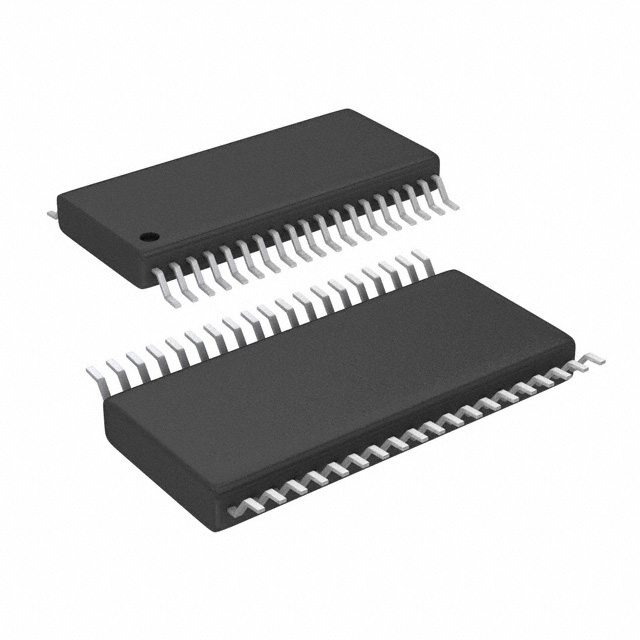SN65LVDS389DBT
Product Overview
- Category: Integrated Circuit (IC)
- Use: LVDS Serializer/Deserializer
- Characteristics:
- High-speed data transmission
- Low-voltage differential signaling
- Robust noise immunity
- Compact package
- Package: TSSOP-56
- Essence: Converts parallel data to serial data and vice versa using LVDS technology
- Packaging/Quantity: Tape and reel, 2500 units per reel
Specifications
- Supply Voltage Range: 3.0V to 3.6V
- Operating Temperature Range: -40°C to +85°C
- Data Rate: Up to 400 Mbps
- Number of Channels: 18
- Input/Output Interface: LVCMOS/LVTTL
- ESD Protection: ±8kV HBM, ±500V CDM
Pin Configuration
The SN65LVDS389DBT has a total of 56 pins. The pin configuration is as follows:
- VCCO
- GND
- VCC
- GND
- RIN0P
- RIN0N
- ROUT0P
- ROUT0N
- RIN1P
- RIN1N
- ROUT1P
- ROUT1N
- RIN2P
- RIN2N
- ROUT2P
- ROUT2N
- RIN3P
- RIN3N
- ROUT3P
- ROUT3N
- RIN4P
- RIN4N
- ROUT4P
- ROUT4N
- RIN5P
- RIN5N
- ROUT5P
- ROUT5N
- RIN6P
- RIN6N
- ROUT6P
- ROUT6N
- RIN7P
- RIN7N
- ROUT7P
- ROUT7N
- RIN8P
- RIN8N
- ROUT8P
- ROUT8N
- CLKINP
- CLKINN
- CLKOUTP
- CLKOUTN
- VREFP
- VREFN
- GND
- VCC
- GND
- VCCO
Functional Features
- Converts parallel data to serial data and vice versa
- Supports high-speed data transmission up to 400 Mbps
- Utilizes Low-Voltage Differential Signaling (LVDS) technology for noise immunity
- Provides 18 channels for data transmission
- Offers ESD protection for enhanced reliability
Advantages and Disadvantages
Advantages: - High-speed data transmission capability - Robust noise immunity due to LVDS technology - Compact package for space-constrained applications - Wide supply voltage range for flexibility
Disadvantages: - Limited number of channels compared to some alternatives - Requires LVCMOS/LVTTL interface for compatibility
Working Principles
The SN65LVDS389DBT operates by converting parallel data into a serial stream using LVDS technology. It accepts input data through the parallel inputs and converts it into a differential signal. This differential signal is then transmitted through the LVDS outputs. On the receiving end, the differential signal is converted back into parallel data.
Detailed Application Field Plans
The SN65LVDS389DBT is commonly used in various applications that require high-speed data transmission with noise immunity. Some of the specific application fields include:
- Display Systems: Used in LCD monitors, televisions, and digital signage for transmitting video data.
- Industrial Automation: Employed in control systems and factory automation for reliable data transmission.
- Automotive Electronics: Integrated into automotive infotainment systems and driver assistance modules.
- Medical Equipment: Utilized in medical imaging devices and patient monitoring systems.
- Communication Systems: Incorporated in network switches, routers, and high-speed data communication equipment.
Detailed and Complete Alternative Models
- SN65LVDS389DRBT: Similar to SN65LVDS389DBT but offered in a different package (SOIC-56).
- SN65LVDS389PW: LVDS Serializer/Deserializer with similar specifications but in a different package (TSSOP-48).
- SN65LVDS389PWR: Same as SN65LVDS389PW but offered in tape and reel packaging.
- SN65LVDS389DGG: LVDS Serializer/Deserializer with additional features and higher data rate capability.
Note: This is not an exhaustive list of alternative models. Please refer to the manufacturer's documentation for a complete list of alternatives.
*
Senaraikan 10 soalan dan jawapan biasa yang berkaitan dengan aplikasi SN65LVDS389DBT dalam penyelesaian teknikal
Sure! Here are 10 common questions and answers related to the application of SN65LVDS389DBT in technical solutions:
Q: What is SN65LVDS389DBT? A: SN65LVDS389DBT is a high-speed differential line driver and receiver designed for applications that require high data rates and low power consumption.
Q: What is the maximum data rate supported by SN65LVDS389DBT? A: SN65LVDS389DBT supports data rates up to 400 Mbps, making it suitable for high-speed communication applications.
Q: Can SN65LVDS389DBT be used for long-distance communication? A: Yes, SN65LVDS389DBT is designed to provide robust signal transmission over long distances, typically up to several meters.
Q: What voltage levels does SN65LVDS389DBT support? A: SN65LVDS389DBT operates with a supply voltage range of 3.0V to 3.6V and supports LVDS (Low Voltage Differential Signaling) levels.
Q: Is SN65LVDS389DBT compatible with other LVDS devices? A: Yes, SN65LVDS389DBT is fully compatible with other LVDS devices, allowing for easy integration into existing LVDS-based systems.
Q: Can SN65LVDS389DBT be used in automotive applications? A: Yes, SN65LVDS389DBT is suitable for automotive applications due to its wide operating temperature range and robustness against electromagnetic interference (EMI).
Q: Does SN65LVDS389DBT have built-in ESD protection? A: Yes, SN65LVDS389DBT incorporates built-in ESD protection on all pins, ensuring reliable operation in harsh environments.
Q: Can SN65LVDS389DBT be used in point-to-point or multi-drop configurations? A: SN65LVDS389DBT can be used in both point-to-point and multi-drop configurations, providing flexibility in system design.
Q: What is the power consumption of SN65LVDS389DBT? A: SN65LVDS389DBT has low power consumption, typically drawing less than 10 mA of supply current.
Q: Are evaluation boards or reference designs available for SN65LVDS389DBT? A: Yes, Texas Instruments provides evaluation boards and reference designs to help users quickly prototype and implement SN65LVDS389DBT in their applications.
Please note that these answers are general and may vary depending on specific application requirements. It's always recommended to refer to the datasheet and application notes for detailed information.


